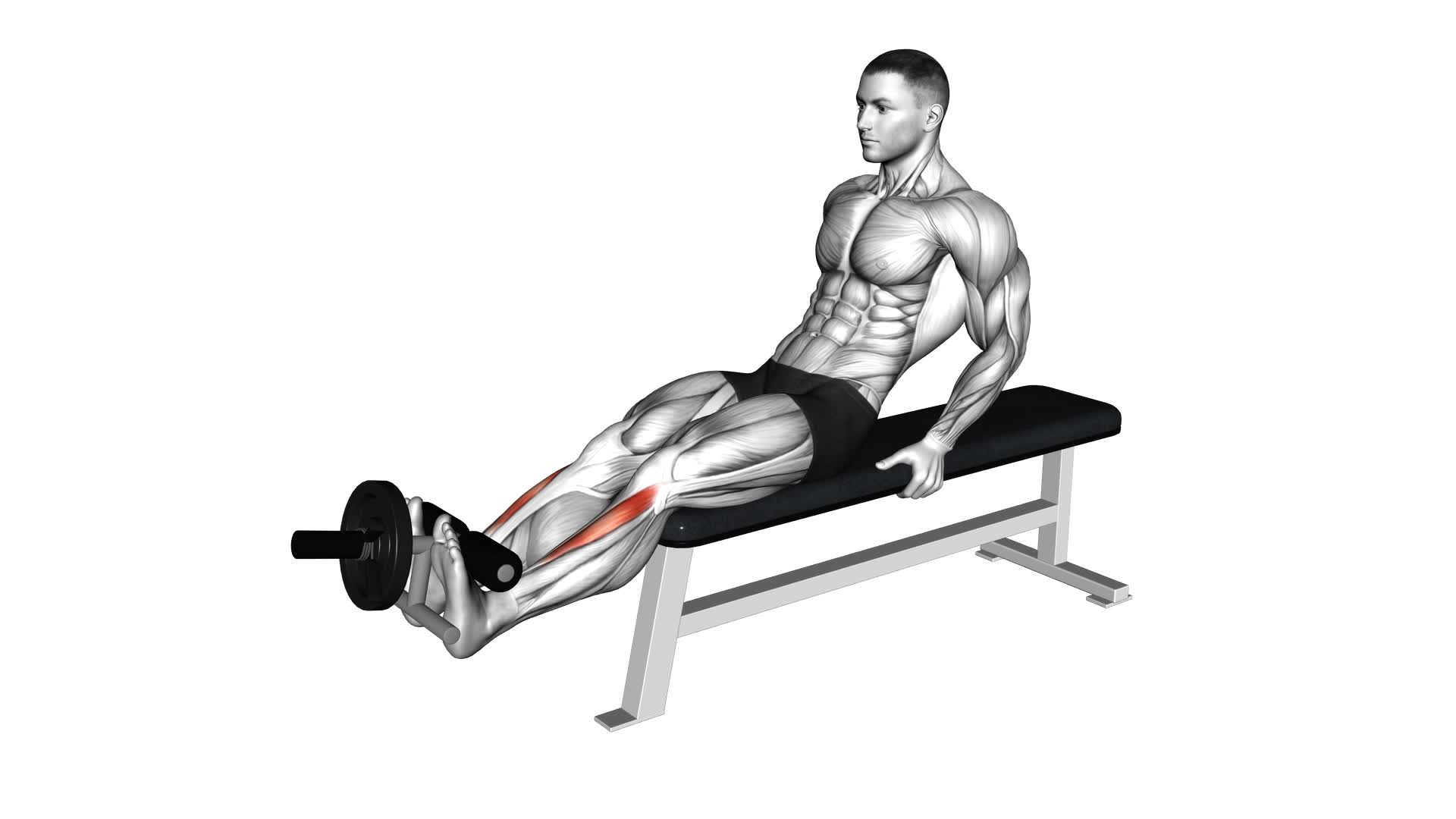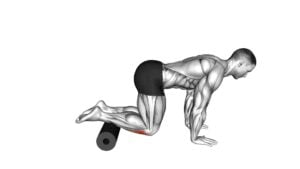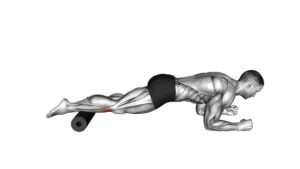Weighted Plate Tibialis Anterior Curl (male) – Video Exercise Guide & Tips

Looking to strengthen your tibialis anterior muscles? Check out this video exercise guide for the weighted plate tibialis anterior curl.
Watch This Exercise Video
In just a few minutes a day, you can reap the benefits of this exercise, including improved ankle stability and balance.
All you need is a weighted plate and a few minutes of your time. Follow along with the proper form and technique demonstrated in the video to maximize the effectiveness of your workout.
Let's get started!
Key Takeaways
- The weighted plate tibialis anterior curl strengthens the tibialis anterior muscle.
- It improves ankle stability and balance.
- The exercise enhances lower leg function and helps prevent shin splints.
- It increases overall lower body strength.
Benefits of the Weighted Plate Tibialis Anterior Curl
You will experience enhanced strength and stability in your lower legs through the Weighted Plate Tibialis Anterior Curl. This exercise specifically targets the tibialis anterior muscle, which is located on the front of your shin. By strengthening this muscle, you can improve your overall lower leg function and prevent injuries such as shin splints.
One of the key benefits of the Weighted Plate Tibialis Anterior Curl is its ability to increase ankle stability. This is important because strong and stable ankles are crucial for maintaining balance and preventing ankle sprains. Additionally, by strengthening the tibialis anterior muscle, you can improve your overall lower body strength, which can enhance your performance in various sports and activities.
Another benefit of this exercise is its ability to improve foot and ankle mobility. The tibialis anterior muscle plays a role in dorsiflexion, which is the movement that allows you to lift your toes towards your shins. By strengthening this muscle, you can improve your range of motion in the ankle joint, making movements such as walking, running, and jumping more efficient.
Equipment Needed for the Exercise
To perform the Weighted Plate Tibialis Anterior Curl exercise, you'll need a weighted plate. Here are the equipment needed and exercise modifications you should consider:
- Weighted Plate: Choose a plate that's comfortable for you to hold and has a suitable weight for your fitness level. Start with a lighter plate and gradually increase the weight as you get stronger.
- Exercise Mat: Place an exercise mat on the floor to provide cushioning and support for your knees and ankles during the exercise.
- Resistance Band: You can use a resistance band to add an extra challenge to the exercise. Attach one end of the band to a stable object and loop the other end around your foot. This will provide resistance as you curl your foot upwards.
By incorporating these equipment and exercise modifications, you can enhance the effectiveness of the Weighted Plate Tibialis Anterior Curl exercise and target your tibialis anterior muscles more effectively.
Now, let's move on to the next section to learn about the proper form and technique for this exercise.
Proper Form and Technique for the Exercise
To perform the Weighted Plate Tibialis Anterior Curl exercise with proper form and technique, there are a few important points to keep in mind.
First, foot positioning is crucial to target the tibialis anterior muscle effectively.
Second, using muscle activation cues, such as dorsiflexing the foot and squeezing the shin muscles, can help maximize the engagement of the target muscle.
Foot Positioning Importance
For optimal form and technique during the Weighted Plate Tibialis Anterior Curl exercise, it's crucial to pay careful attention to the positioning of your feet. Proper foot positioning not only ensures that you're targeting the correct muscles but also helps maintain ankle stability throughout the movement.
Here are some key points to keep in mind:
- Start by standing with your feet hip-width apart.
- Position your feet parallel to each other, with toes pointing forward.
- Distribute your weight evenly between both feet.
By following these guidelines, you'll create a stable foundation for the exercise, allowing you to perform the Tibialis Anterior Curl with proper form and minimize the risk of injury.
Muscle Activation Cues
To ensure proper form and technique during the Weighted Plate Tibialis Anterior Curl exercise, focus on activating the targeted muscles and maintaining correct body positioning.
Muscle activation cues are essential for performance optimization. Begin by placing a weighted plate on your foot, ensuring it's securely fastened.
Position yourself on a bench or elevated surface with your legs extended and your heels hanging off the edge. Keep your upper body upright and engage your core muscles for stability.
As you curl your toes towards your shins, focus on contracting and activating your tibialis anterior muscle. Maintain control throughout the movement and avoid using momentum.
Common Form Mistakes
Avoid these common form mistakes to ensure proper form and technique for the Weighted Plate Tibialis Anterior Curl exercise:
- Improper foot placement: Make sure your feet are positioned flat on the ground and shoulder-width apart. This provides a stable base and helps maintain balance throughout the exercise.
- Lack of ankle stability: Keep your ankles stable throughout the movement by engaging the muscles in your lower legs. Avoid excessive movement or rolling of the ankles to prevent injury and maximize the effectiveness of the exercise.
- Using too much weight: Start with a lighter weight and gradually increase as you gain strength and stability. Using too much weight can compromise your form and increase the risk of injury.
By avoiding these common form mistakes, you can perform the Weighted Plate Tibialis Anterior Curl with proper technique and minimize the risk of injury.
Now, let's move on to the next section for tips to maximize the effectiveness of the exercise.
Tips to Maximize the Effectiveness of the Exercise
To maximize the effectiveness of the weighted plate tibialis anterior curl, there are a few key points to keep in mind.
First, focus on maintaining proper form throughout the exercise, keeping your core engaged and your back straight.
Additionally, pay attention to your breathing, exhaling as you curl your toes up and inhaling as you lower them down.
Proper Form Techniques
You can enhance the effectiveness of the Weighted Plate Tibialis Anterior Curl by focusing on proper form techniques. By following these tips, you can maximize the benefits and reduce the risk of injury:
- Maintain a neutral spine throughout the exercise to ensure proper alignment and prevent strain on the lower back.
- Keep your core engaged and your shoulders relaxed to stabilize your body and isolate the tibialis anterior muscle.
- Control the movement and avoid using momentum by moving in a slow and controlled manner.
By practicing proper form techniques, you can target the specific muscle groups more effectively and reduce the risk of injury.
Remember to start with lighter weights and gradually increase the load as you become more comfortable with the exercise.
Breathing Techniques
Breathe deeply and rhythmically to optimize the effectiveness of the Weighted Plate Tibialis Anterior Curl exercise. Proper breathing techniques can greatly enhance your performance and maximize the benefits of this exercise.
One effective technique is diaphragmatic breathing, also known as belly breathing. This involves taking deep breaths, allowing your belly to expand as you inhale and contract as you exhale. Diaphragmatic breathing helps to engage the diaphragm and increase oxygen intake, promoting relaxation and reducing stress.
Common Mistakes to Avoid While Performing the Exercise
When performing the Weighted Plate Tibialis Anterior Curl exercise, be mindful of the common mistakes that can hinder your progress. To ensure you're getting the most out of this exercise and avoiding unnecessary injuries, pay attention to the following:
- Improper form: One of the most common mistakes isn't maintaining proper form throughout the exercise. Make sure to keep your back straight, shoulders relaxed, and core engaged. Avoid rounding your back or using momentum to lift the weight.
- Using too much weight: It's important to start with a weight that you can handle comfortably. Using too much weight can lead to poor form and increase the risk of injury. Gradually increase the weight as your strength improves.
- Neglecting the full range of motion: Another mistake to avoid isn't fully extending and flexing your ankle during the exercise. This can limit the effectiveness of the workout. Make sure to fully extend your ankle at the top of the movement and flex it as much as possible at the bottom.
Variations and Progressions of the Weighted Plate Tibialis Anterior Curl
To further challenge your tibialis anterior muscles and continue your progress, you can explore different variations and progressions of the Weighted Plate Tibialis Anterior Curl exercise.
Variations allow you to target the muscles from different angles, while progressions help you increase the difficulty of the exercise as you get stronger.
One variation of the Weighted Plate Tibialis Anterior Curl is the Single-Leg Variation. Instead of using both legs to perform the exercise, you'll only use one leg at a time. This variation requires more strength and stability in the working leg, intensifying the workout for your tibialis anterior.
Another variation is the Eccentric Variation. In this variation, you'll focus on the eccentric phase of the exercise, which is the lowering portion. Slowly lower the weight back down to the starting position, emphasizing the lengthening of the tibialis anterior muscle. This variation helps develop strength and control in the muscle.
To progress the Weighted Plate Tibialis Anterior Curl, you can increase the weight of the plate or use a resistance band for added resistance. You can also perform the exercise on an unstable surface, such as a balance board or foam pad, to challenge your stability and engage more muscles in your lower leg.
Frequently Asked Questions
Can the Weighted Plate Tibialis Anterior Curl Help With Improving Balance and Stability?
Improving balance and stability is crucial for overall fitness. One exercise that can help with this is the weighted plate tibialis anterior curl.
By targeting the tibialis anterior muscle, this exercise strengthens the ankles, which are essential for maintaining balance.
Adding weight to the exercise further challenges your stability, forcing your muscles to work harder.
Incorporating this exercise into your routine can improve balance and stability, leading to better overall performance in various physical activities.
Is It Necessary to Use a Weighted Plate for This Exercise, or Can It Be Done Without Any Additional Weight?
You don't necessarily need to use a weighted plate for the Tibialis Anterior Curl exercise. There are alternative ways to perform this exercise without any additional weight.
However, using a weighted plate can provide added resistance and benefits for athletes looking to increase strength and stability in their lower legs.
It's important to consider your fitness goals and consult with a professional trainer to determine the best approach for your specific needs.
How Often Should the Weighted Plate Tibialis Anterior Curl Be Performed for Optimal Results?
For optimal results, it's important to consider the frequency of the weighted plate tibialis anterior curl. This exercise, along with its variations, should be performed regularly but not excessively.
Aim to include it in your workout routine about 2-3 times per week. This will allow for proper rest and recovery while still challenging the muscle.
Remember to listen to your body and adjust the frequency as needed to avoid overtraining and injury.
Are There Any Alternative Exercises That Can Target the Same Muscles as the Weighted Plate Tibialis Anterior Curl?
If you're looking for alternative exercises that target the same muscles as the weighted plate tibialis anterior curl, there are a few options you can try.
One alternative exercise is the seated tibialis raise, which involves sitting down and raising your toes towards your shin.
Another option is the standing calf raise, which works the tibialis anterior as well as the calf muscles.
These exercises can help strengthen and tone the muscles in your lower leg.
Can the Weighted Plate Tibialis Anterior Curl Be Beneficial for Individuals With Ankle Injuries or Weak Ankles?
The weighted plate tibialis anterior curl can be beneficial for individuals with ankle injuries or weak ankles. This exercise targets the tibialis anterior muscle, which helps with ankle stability and prevents injuries. The added weight from the plate increases the challenge and strengthens the muscles even more.
However, it's important to modify the exercise if you have ankle injuries. Consult with a professional trainer or therapist to find alternative exercises that can provide similar benefits without worsening your condition.
Conclusion
In conclusion, the weighted plate tibialis anterior curl is a beneficial exercise for strengthening the tibialis anterior muscle. It requires minimal equipment and can be easily incorporated into a workout routine.
By maintaining proper form and technique, individuals can maximize the effectiveness of the exercise. It's important to avoid common mistakes and gradually progress to more challenging variations.
Overall, this exercise can help improve lower leg strength and stability.

Author
Years ago, the spark of my life’s passion ignited in my mind the moment I stepped into the local gym for the first time. The inaugural bead of perspiration, the initial endeavor, the very first surge of endorphins, and a sense of pride that washed over me post-workout marked the beginning of my deep-seated interest in strength sports, fitness, and sports nutrition. This very curiosity blossomed rapidly into a profound fascination, propelling me to earn a Master’s degree in Physical Education from the Academy of Physical Education in Krakow, followed by a Sports Manager diploma from the Jagiellonian University. My journey of growth led me to gain more specialized qualifications, such as being a certified personal trainer with a focus on sports dietetics, a lifeguard, and an instructor for wellness and corrective gymnastics. Theoretical knowledge paired seamlessly with practical experience, reinforcing my belief that the transformation of individuals under my guidance was also a reflection of my personal growth. This belief holds true even today. Each day, I strive to push the boundaries and explore new realms. These realms gently elevate me to greater heights. The unique combination of passion for my field and the continuous quest for growth fuels my drive to break new ground.



